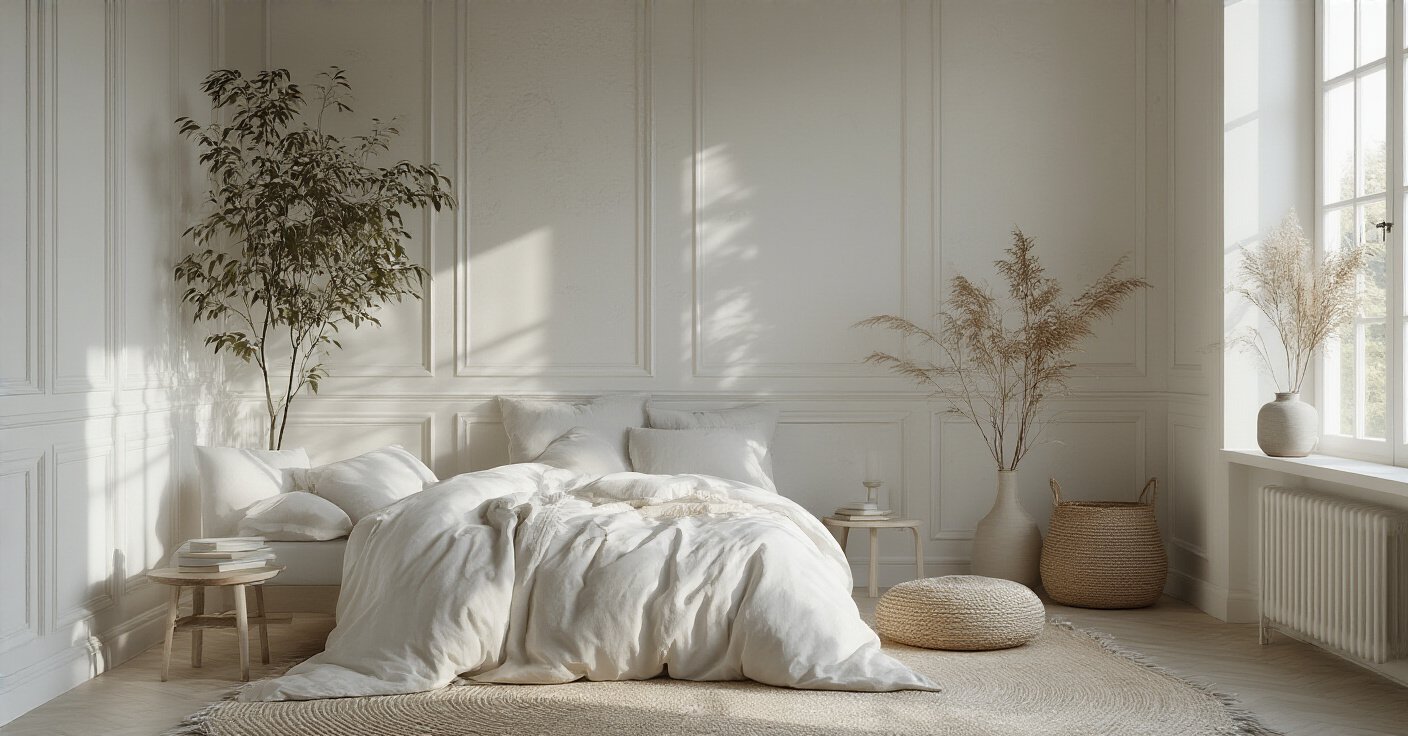You know what people always ask me about white bedrooms? “Isn’t it boring? And a total nightmare to keep clean?” And I get it. We’ve all seen those pictures of white rooms that look more like a hospital wing than a cozy retreat. People think it’s a simple, even lazy, design choice.
But here’s the secret: A truly brilliant white bedroom is one of the most intentional, sophisticated, and healthy spaces you can create. It’s not about stripping away color; it’s about creating a calm, restorative canvas where light, texture, and your own personality can really shine. The biggest misconception is that “white is white.” Anyone who tells you to just grab a can of “ceiling white” for your walls is setting you up for a room that feels flat, cold, and probably smells like a paint factory. We can do so much better.
My environmental science background gets fired up thinking about indoor air quality, and my design eye cringes at a missed opportunity for beauty. The good news is that creating a space that’s both stunningly beautiful and healthy is not only possible, it’s actually easier when you know what really matters. Forget the noise. Let’s talk about how to do this the right way.
The White Canvas: Foundation & Shades
Think of this part as building the “bones” of your sanctuary. Before you even think about pillows or art, we need to get the foundation right. This is where we make choices that will impact the light, the feel, and even the air you breathe for years to come.
1. Select the Perfect White Paint Tone for Optimal Ambiance
People get completely overwhelmed by the wall of white paint chips at the hardware store. Here’s the only thing you need to remember: no white is truly pure white. Every single one has a subtle undertone—a hint of yellow, blue, grey, or even pink. This isn’t a bug; it’s a feature! A warm white with a creamy undertone will make a north-facing room feel sunny and cozy, while a cool white with a whisper of grey can make a sun-drenched room feel crisp and serene.

The single most important thing here, though, is choosing a paint that’s healthy. Your bedroom is where your body rests and repairs itself. The last thing you want is to be breathing in volatile organic compounds (VOCs) all night long. Always, always opt for a Zero-VOC or Low-VOC paint. The extra few dollars per can is one of the best investments you can make in your family’s health. Trust me, I once helped a client who was getting constant headaches in her newly painted bedroom—we traced it back to the cheap, high-VOC paint the contractors had used.
With your healthy, beautifully toned paint selected, you’re not just painting a wall; you’re creating an envelope of light and calm. This single choice is the backdrop for everything else we’re about to do.
2. Embrace Crisp White Walls with Subtle Undertone Nuances
I know, this sounds a lot like the last point, but it’s worth repeating because it’s the number one mistake I see people make. They pick a white from a tiny swatch under fluorescent store lights and are shocked when it looks totally different on their walls. Your room’s light is unique. It changes from morning to afternoon, from sunny days to cloudy ones.

Here’s the shortcut I wish I’d known years ago: Forget the tiny paint chips. Get the large, 2’x2′ peel-and-stick samples. Stick them on different walls in your bedroom. Live with them for a couple of days. Watch how they change as the light moves through the room. See how they look next to your floor, your furniture, and in the evening with your lamps on. This simple test is the best way to avoid a ten-gallon mistake and find the white that truly makes your specific space sing.
Now that we’ve handled the walls, let’s look down. The surface under your feet plays a huge role in the room’s overall brightness and health.
3. Choose White or Light Wood Flooring to Enhance Room Brightness
A light-colored floor is like a giant reflector, bouncing sunlight all around the room and making everything feel more open and airy. It works hand-in-hand with your white walls to create that expansive feeling. While you could go for a literal white floor, I usually steer people towards light-toned woods. It brings in that crucial element of natural warmth.

From an environmental standpoint, this is a great place to make a lasting impact. Instead of vinyl plank—which is essentially a sheet of plastic—consider flooring with character and a conscience. Look for reclaimed wood from an old barn, FSC-certified hardwood (which guarantees it’s from a responsibly managed forest), or even sustainable options like cork or bamboo. These materials not only look beautiful and connect your home to nature, but a well-cared-for wood floor will last a lifetime, reducing waste and adding real value to your home.
With the largest surfaces—walls and floors—working in harmony, it’s time to anchor the space with the furniture that will form your serene base.
4. Invest in Core White Furniture for a Seamless Base
Please, can we talk about “fast fashion” furniture? Everyone is so tempted by that super cheap dresser, but it’s a trap. It’s typically made of particleboard held together with formaldehyde-based glues that can off-gas into your bedroom for years. And let’s be honest, it will probably start to sag or chip within a year or two, ending up in a landfill.
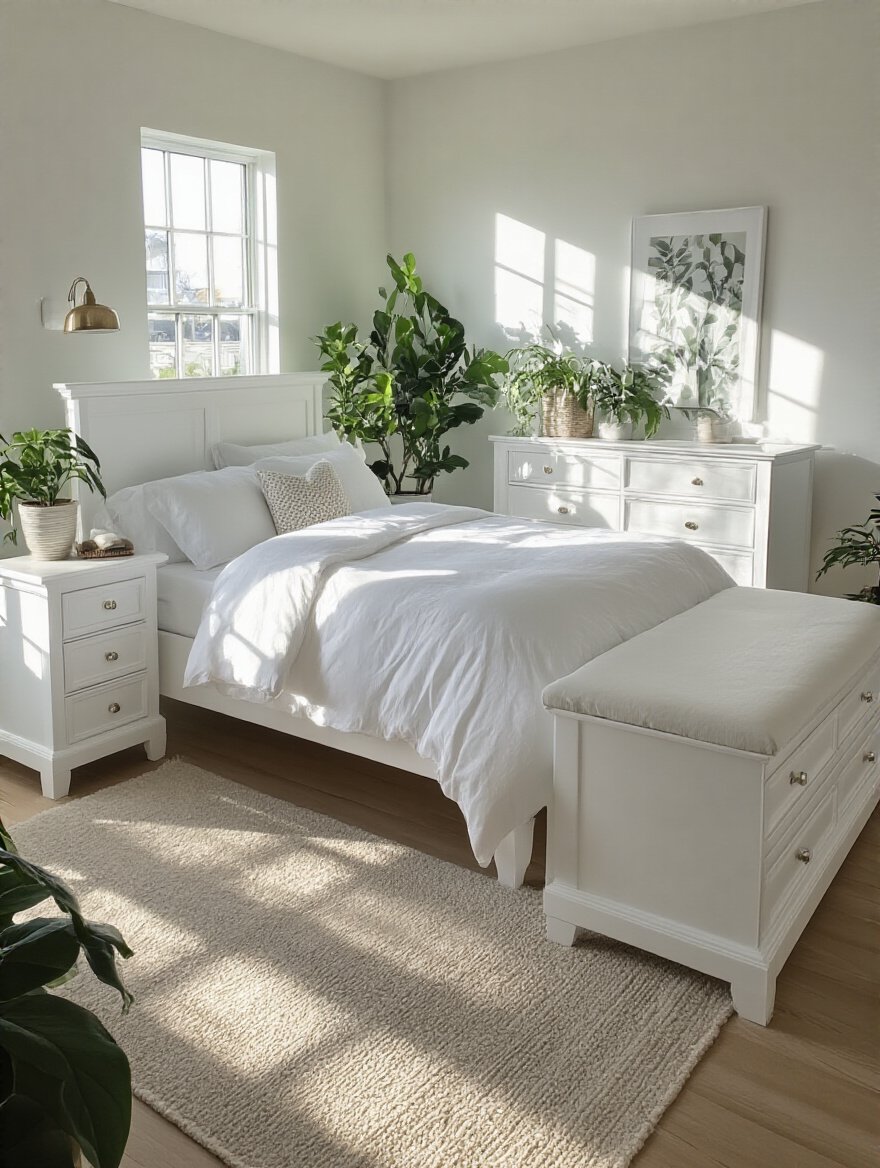
Instead, think long-term. Investing in a few core pieces of solid wood furniture is a powerful sustainable choice. You can find incredible, well-built vintage pieces at a fraction of the cost of new and give them a fresh life with a coat of non-toxic white paint. Or, if you’re buying new, look for makers who use solid, sustainably sourced wood. A beautiful white bed frame, dresser, and nightstands will create that seamless, calm backdrop and will last for decades, becoming heirlooms instead of trash.
Layering for Luxury: Texture & Textiles
Okay, the canvas is prepped. Now for the magic. This is how we take a room from “white” to “wow.” It’s all about layering different textures and natural fibers to create a space that’s incredibly cozy and begs you to touch it.
5. Incorporate Luxurious White Linens for a Boutique Hotel Feel
That feeling of slipping into a bed at a five-star hotel? You can have that every single night. And the secret isn’t an absurdly high thread count; it’s the quality and type of the fiber. A 300-thread-count sheet made from high-quality, long-staple organic cotton or natural linen will feel infinitely more luxurious, breathable, and soft than a 1000-thread-count sheet made from a sweaty polyester blend.

This is a huge one for your health, too. Natural fibers like organic cotton, linen, or bamboo breathe with you. They wick moisture away from your skin, helping you regulate your temperature for a deeper, more restorative sleep. Plus, choosing organic means you’re sleeping on fibers grown without the cocktail of pesticides and chemicals used on conventional cotton crops. It’s a choice that’s kinder to your skin and the planet.
Once you have that incredible foundation of sheets, we can start adding layers of touchable, cozy comfort.
6. Blend Varied Textures with Knit Throws and Plush Rugs
This is the antidote to the “sterile white room” problem. Imagine your white bed: on top of your smooth linen duvet, you add a chunky white cable-knit throw. Beside the bed, your feet land on a soft, high-pile wool or plush cotton rug. You’ve just added incredible depth and coziness without adding a single drop of color. Texture is what makes a monochromatic room feel rich and inviting.

When you’re choosing these pieces, think about their source. A beautiful rug woven from natural, undyed wool is not only soft and durable, but wool is also a rapidly renewable resource that’s naturally flame-retardant and antimicrobial. Throws made of recycled cotton or chunky wool add that cozy hygge feeling while being a conscious choice. It’s about building a sensory experience that feels as good as it looks.
To elevate that comfort, let’s carve out a dedicated spot just for relaxing with an inviting accent chair.
7. Add Comfort with Soft Boucle or Sherpa Accent Chairs
Every bedroom deserves a cozy corner for reading or just quiet contemplation. An accent chair upholstered in a super-tactile fabric like boucle or sherpa is the perfect way to create this. It becomes a sculptural, soft focal point that screams “come relax here.”

A little heads-up: a lot of the trendy, cheap “sherpa” you see is just polyester, which is a plastic fabric derived from petroleum. For a truly luxurious and sustainable piece, look for chairs upholstered in natural wool boucle or find a beautiful vintage chair with great bones and have it reupholstered in a high-quality, natural fabric. I once found a gorgeous mid-century armchair for a client, and we had it recovered in a creamy wool boucle. It became the star of the room and will last for another 50 years.
Now, with our larger textured pieces in place, let’s zoom in on the small details that make a huge difference.
8. Utilize Subtle Patterns on Pillows to Prevent Flatness
When I say “pattern,” don’t immediately think of bold florals or busy geometrics. In a white bedroom, the most elegant patterns are the ones you almost feel more than you see. Think of a white-on-white embroidered lumbar pillow, the subtle herringbone weave in a cushion cover, or the dimensional texture of a matelassé sham.

These tone-on-tone patterns are what create that layered, custom-designed look. They catch the light in different ways, adding subtle shadows and highlights that prevent the bed from looking like one flat white rectangle. This is also a wonderful opportunity to support artisans by looking for pillows with hand-blocked prints or intricate, traditional weaving. It adds a story and soul to your space.
From the bed, our eye moves to the windows. How we dress them is key to controlling the light and softness of the room.
9. Layer Sheer White Curtains to Filter Light Beautifully
Sheer white curtains are like a soft-focus filter for your room. They diffuse harsh, direct sunlight into a gentle, ethereal glow that makes everything look better. They give you a sense of privacy during the day without sacrificing that precious natural light. It’s a simple change that can completely transform the ambiance of a room.

For the most beautiful effect, choose sheers made from natural fibers like linen or a lightweight organic cotton. They have a natural, elegant drape that synthetic fabrics just can’t match. And here’s a pro tip that works in every single room: hang your curtain rod high and wide. Mount it 6-12 inches above the window frame and extend it 10-12 inches on either side. This tricks the eye into thinking your ceilings are higher and your windows are bigger. It’s an instant architectural upgrade.
Infusing Life: Accents & Organic Elements
A white room needs life! Without warmth and personality, it can feel like a gallery space, not a home. This is where we bring in the elements that ground the design and make it feel uniquely yours: nature, sparkle, and meaningful objects.
10. Introduce Warm Wood Tones Through Furniture or Decor
Wood is the perfect antidote to the coldness that a white room can sometimes have. It’s a natural, grounding element that immediately adds warmth and character. This is biophilic design 101: connecting our indoor spaces with the natural world to improve our well-being. A warm walnut dresser, an oak-framed mirror, or even just a small wooden stool next to the tub can completely change the feel of a room.
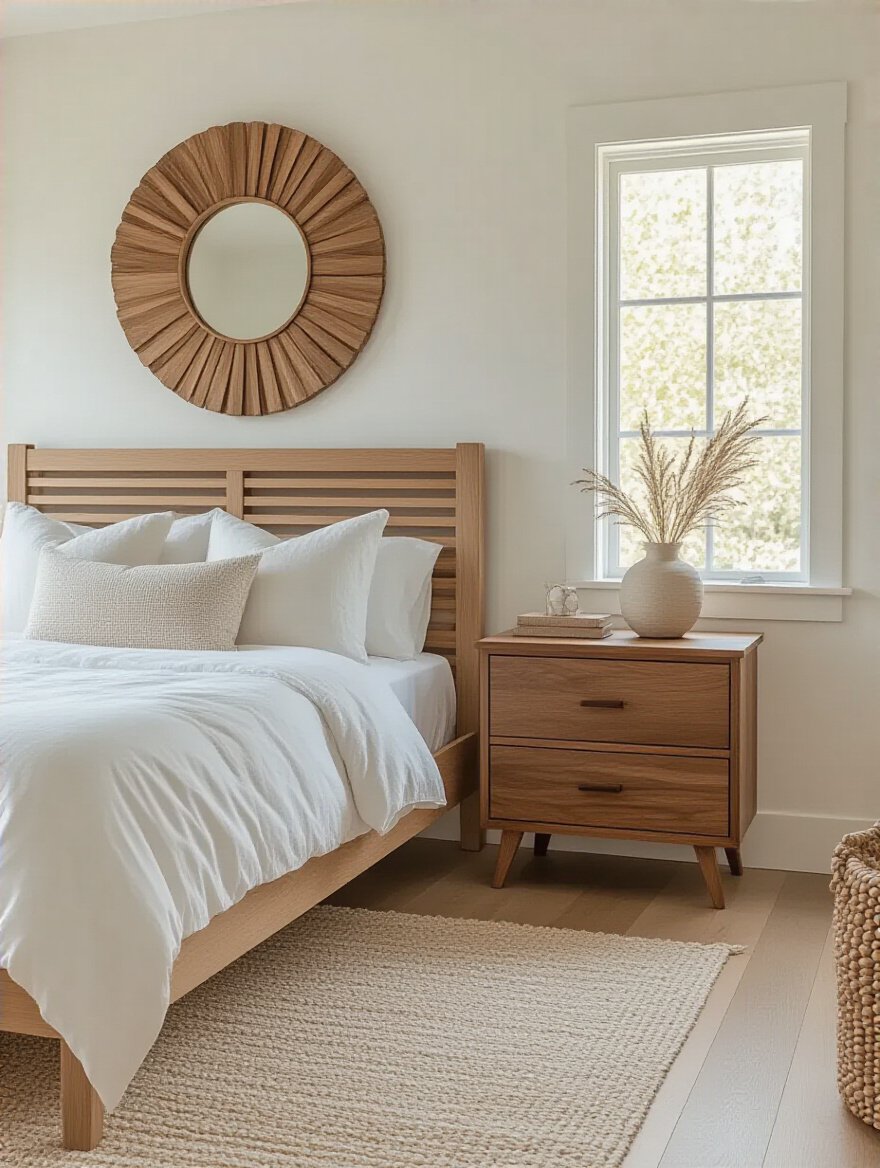
My favorite way to do this is with reclaimed wood. It has a story, a patina, and a soul that you can’t buy new. If you are buying new, look for the FSC (Forest Stewardship Council) certification. That little logo is your guarantee that the wood was harvested in a way that protects forests for future generations. It’s a small detail that makes a big difference.
Next to wood, the most powerful way to bring life into your space is by adding, well, actual life.
11. Place Lush Greenery for a Refreshing Organic Contrast
Please don’t think of plants as just decor. Think of them as living, breathing roommates that work for you! Plants are the ultimate design accessory—they add a sculptural element, a pop of vibrant color, and they literally clean the air you breathe. That NASA study you hear about is real; plants like the Snake Plant, ZZ Plant, and Pothos are incredibly effective at filtering out common indoor air toxins.
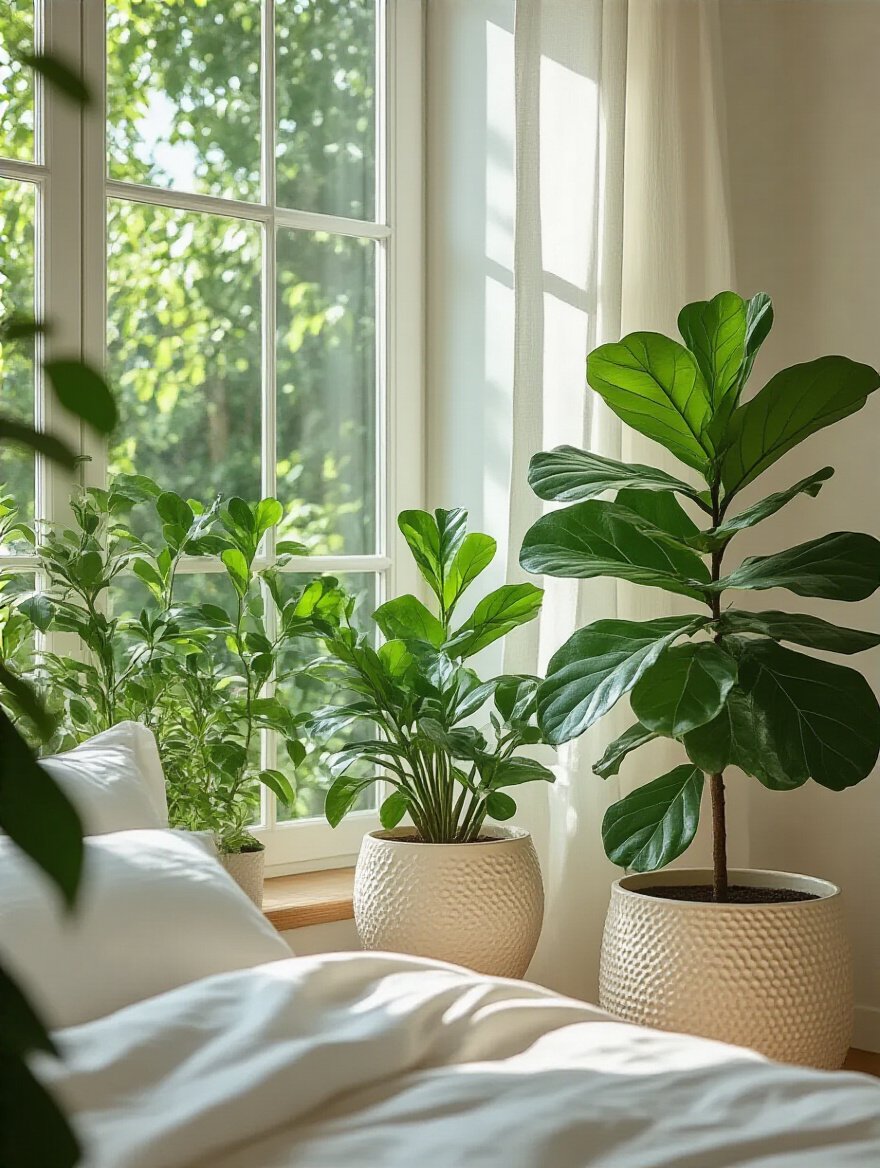
In a white bedroom, a lush green plant becomes a living piece of art. The vibrant green against the crisp white is a stunning, timeless contrast. Start with one or two easy-care plants in a corner or on your dresser. It’s the fastest and most affordable way to infuse your sanctuary with life, energy, and a dose of nature.
With the grounding elements of wood and plants in place, it’s time for a little bit of sophisticated shine.
12. Add Metallic Accents for a Touch of Sophisticated Sparkle
A little bit of metal is like jewelry for your room. It catches the light and adds a touch of glamour and sophistication. The key is to be intentional. Think about a sleek brass reading lamp by the bed, a simple silver frame on a photo, or updating the hardware on your dresser to a brushed bronze.

Instead of trendy finishes that will date themselves, stick to timeless metals like brass, nickel, or bronze. Look for well-made pieces that have a bit of weight to them. Even better, scout flea markets or antique shops for vintage fixtures. They have a beautiful patina that adds instant character and keeps a perfectly good item out of the landfill.
To add another layer of warmth, let’s explore the cousins of white: the soft, earthy neutrals.
13. Incorporate Soft Greys or Beige for Gentle Color Variation
A truly sophisticated white room is rarely just pure white. It’s a symphony of subtle, related tones. Think about the color of natural, unbleached linen, soft undyed wool, or smooth river stones. Bringing in these soft greys, beiges, and taupes gives the room incredible depth and a more organic, calming feel.

This can be as simple as layering a light grey linen duvet over your white sheets, adding a chunky beige knit throw, or choosing an area rug that has subtle variations of cream and oatmeal. It’s about creating warmth and interest without shouting. These natural, earthy tones are the perfect bridge between the crisp white and the warmer wood elements in the room.
Finally, let’s tackle storage in a way that adds beauty instead of bulk.
14. Use Woven Baskets for Practical Storage with Natural Texture
Clutter is the enemy of a serene space. Woven baskets are my go-to solution because they are the perfect marriage of form and function. They provide practical storage for extra blankets, laundry, or books while adding a beautiful, natural texture that breaks up all the smooth surfaces.

From a sustainability perspective, this is a huge win. Baskets woven from materials like seagrass, jute, and water hyacinth are made from fast-growing, renewable resources. They are an eco-friendly way to get organized and bring another layer of that essential natural texture into your white sanctuary.
Illuminating the Space: Light & Reflections
Light is the single most important—and most free!—design element you have. In a white room, light is everything. It dictates the mood, highlights your beautiful textures, and makes the space feel alive.
15. Strategically Position Mirrors to Amplify Natural Light
This is the oldest trick in the design book for a reason: it works. A mirror doesn’t just show you your reflection; it bounces light. Placing a large mirror directly opposite your main window can literally double the amount of natural light in a room. It also creates an illusion of depth, making any space feel larger and more open.

Forget about clusters of small, dinky mirrors. Go for impact. A single, large, floor-length mirror leaning against a wall or a big, round mirror hung over a dresser will make a much bigger statement and do a much better job of amplifying light. It’s like adding a second window for a fraction of the cost.
Once we’ve maximized our natural light, it’s crucial to layer our artificial light for a perfect evening mood.
16. Select Multi-Level Lighting for Ambient Evening Glow
Relying on a single, harsh overhead light—what designers call the “big light”—is a recipe for a sterile, unflattering room. And from a health perspective, blasting your eyes with bright light right before bed can disrupt your circadian rhythm and make it harder to fall asleep. A great lighting plan is all about layers.

You need three types of light: ambient (your overall gentle light), task (for specific things, like a reading lamp by the bed), and accent (to highlight art or a plant). The absolute non-negotiable shortcut here is to put everything on a dimmer switch. This gives you complete control to transition from bright and functional during the day to a soft, warm, relaxing glow in the evening. Use warm-toned LED bulbs (look for 2700K on the box) to mimic the feel of candlelight.
To keep the look clean, the fixtures themselves should support the design, not fight it.
17. Choose Transparent or White Light Fixtures for Seamless Integration
In a white room, you want the light itself to be the star, not necessarily the light fixture. Choosing fixtures made of clear glass, white ceramic, or a simple white metal helps them blend into the background, preserving that open, airy, and uncluttered feeling. A bulky, dark pendant light can feel like a visual roadblock, stopping the eye and making the ceiling feel lower.

This doesn’t mean boring! Look for fixtures with interesting shapes or subtle textures, like a ribbed glass shade or a matte white ceramic base. The idea is that they contribute to the light and texture of the room without visually shouting for attention. It’s a quiet, confident design choice.
And to round out our lighting plan, let’s make sure we’re getting every last drop of that precious daylight.
18. Optimize Window Treatments for Maximum Daytime Illumination
We talked about using sheer curtains to filter light, but let’s talk about maximizing it. During the day, you want to let as much of that glorious sunlight in as possible. That high-and-wide curtain rod trick is key here, because it allows you to pull the curtain panels completely off the glass, exposing the entire window.

Another brilliant option, especially for windows where you need more privacy control, is top-down/bottom-up shades. They allow you to lower the shade from the top, letting in light while keeping the bottom portion of the window covered. It’s a super flexible solution that lets you manage light and privacy perfectly throughout the day.
Personalizing & Maintaining Your Sanctuary
The design is done, but now we make it a home. This final part is about infusing the space with your soul and creating simple habits to keep your beautiful white sanctuary looking and feeling its best.
19. Display Curated Art or Photos to Reflect Personal Style
A white room is the perfect gallery wall for your life. This is where you transform the space from a beautiful room into your beautiful room. Frame that photo from a memorable trip, support a local artist by buying a small piece you love, or display a textile that has meaning to you. These are the things that tell your story.

This is what turns a house into a home. Don’t worry about what’s trendy; choose pieces that you connect with emotionally. A well-placed piece of meaningful art is what gives a room its soul, preventing it from ever feeling generic or impersonal.
Once you’ve made it personal, the key to keeping it serene is maintaining that sense of calm.
20. Keep Surfaces Clutter-Free for a Serene Minimalist Look
My science brain loves this one. There are actual studies showing that visual clutter increases our levels of cortisol, the stress hormone. A cluttered space literally leads to a stressed mind. In the bedroom, the room dedicated to rest, keeping surfaces clear is not just an aesthetic choice; it’s a mental health choice.

Adopt the ’empty surface’ rule. Aim to keep your nightstand and dresser tops 90% clear, with only a few essential or beautiful items on display. Everything else should have a home in a drawer or a basket. A simple 5-minute ‘reset’ each evening where you put things back in their place can make a world of difference. A clear space helps create a clear mind, setting the stage for deep, restorative sleep.
Finally, let’s talk about how to keep all this beautiful white… well, white.
21. Establish a Simple Cleaning Routine to Maintain Freshness
Don’t panic! A white room isn’t harder to clean; it just shows you when it needs cleaning, which is actually a good thing. You don’t need a cabinet full of harsh, toxic chemicals. A good quality microfiber cloth, a solution of water and white vinegar, and a little baking soda can handle almost all of your cleaning needs. It’s cheaper, so much better for your indoor air quality, and kinder to the planet.
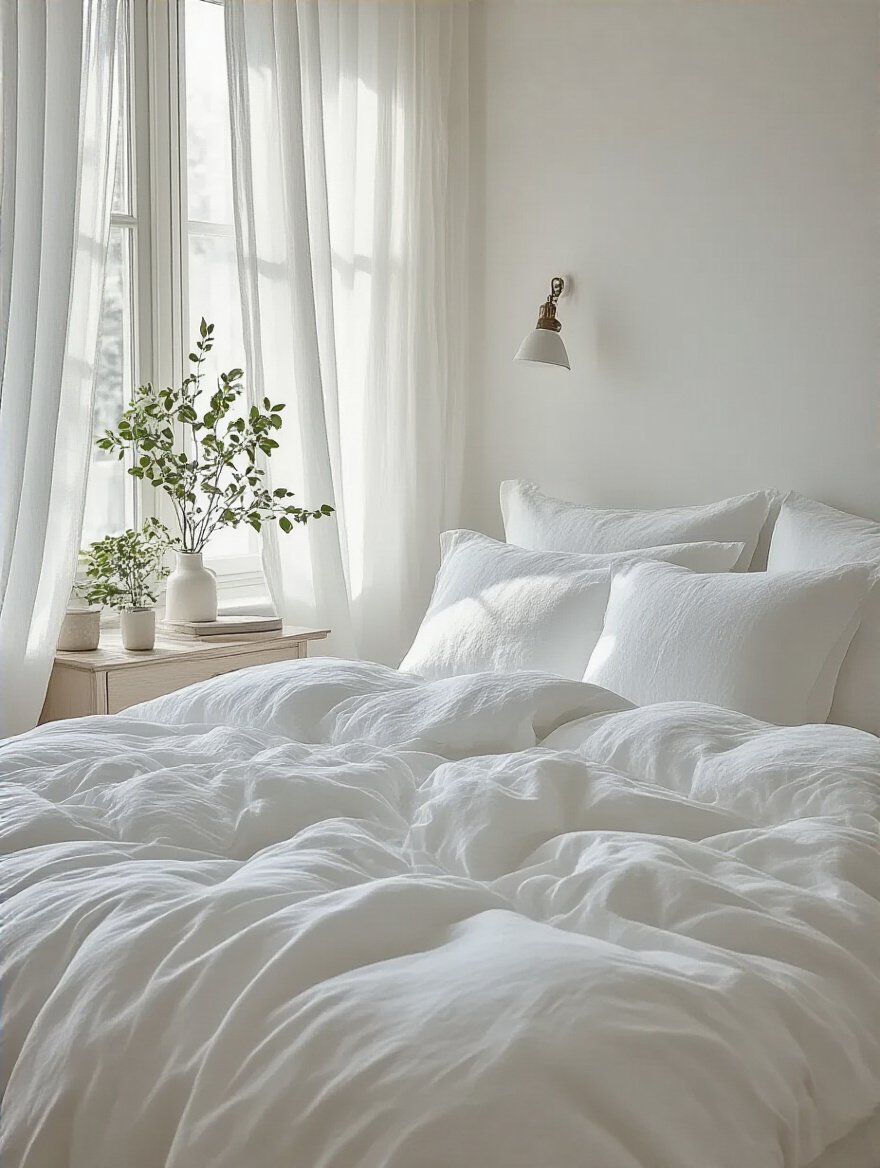
A simple routine is your best friend. A quick daily wipe-down of surfaces, washing your bedding weekly, and regular vacuuming is all it takes. For your white linens, try adding a half-cup of vinegar or a quarter-cup of baking soda to your wash cycle as a natural brightener instead of chlorine bleach, which can actually cause yellowing over time. A clean room is a healthy room, and in the space where you spend a third of your life, that’s a beautiful thing.
Conclusion
So, is a white bedroom boring? Only if you let it be. As you can see, creating a truly brilliant white bedroom is an art form—an exercise in thoughtful, conscious design. It’s about more than just a color; it’s about crafting a sanctuary. By layering natural textures, harnessing light, choosing healthy materials, and infusing the space with your own story, you create a room that is anything but boring. It becomes a serene, sophisticated, and deeply personal retreat.
The power of a well-designed white bedroom is its ability to calm the mind and restore the spirit. It reduces the visual noise of our busy lives, providing a peaceful backdrop that supports rest and rejuvenation. It’s a testament to the idea that our homes can and should be places that nurture our well-being.
So are you ready to create your own haven? Don’t feel like you have to do everything at once. Pick one idea that resonated with you. Maybe it’s finding the perfect, healthy white paint. Maybe it’s investing in a set of organic linen sheets. Or maybe it’s just adding a single, air-purifying plant to your nightstand. Every small, conscious choice builds upon the last, leading you to a home that not only looks incredible but feels incredible, too.
